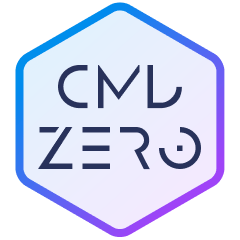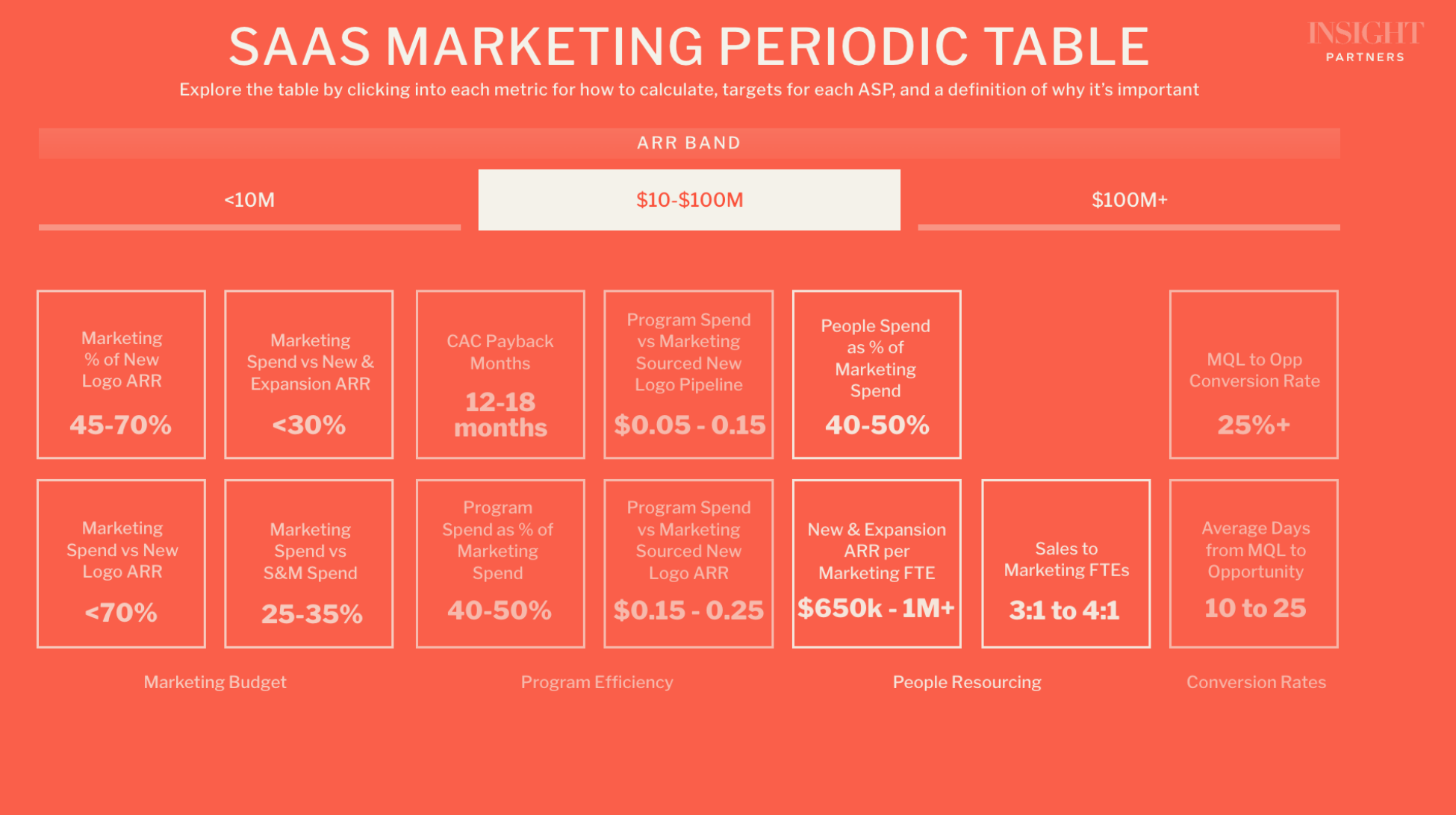AI coding will unlock the next wave of developer productivity and reshape the software supply chain

AI coding tools will improve over time, ushering in a new wave of productivity gains for developers. Slowly but surely, value will “shift left” to AI coding tools as security, ops, and testing issues covered by downstream tooling are avoided altogether because AI considers these things as it generates code.
It seems like overnight, every developer has an AI-powered pair programmer in their pocket. Sourcegraph (an Insight portfolio company) found that 95% of software developers use AI tools like GitHub Copilot, ChatGPT, and Cody (Sourcegraph’s AI code assistant). Now we have an emerging landscape of AI coding tools:
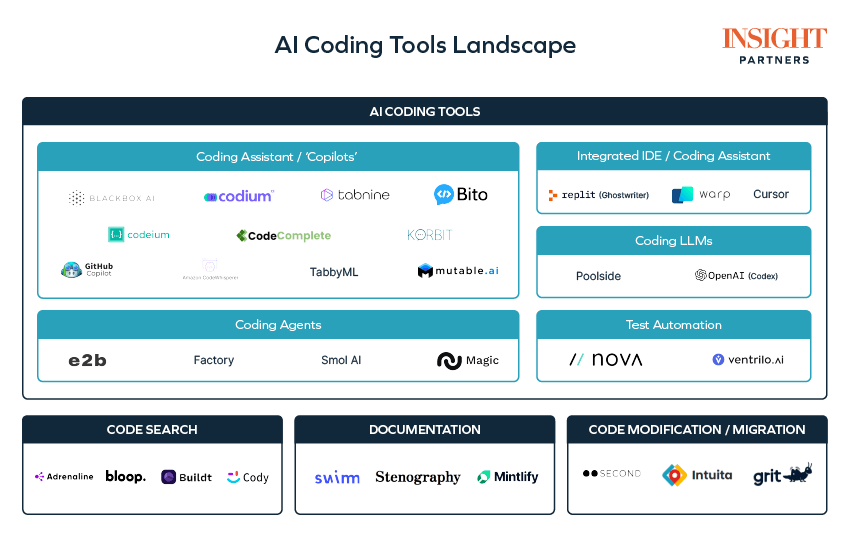
There are lots of new tools out there that use AI to help with coding. They can be plug-ins for coding programs, or tools for searching and migrating code, and even agents that automate workflows. These tools are changing the game by taking on tasks that used to be done by humans typing code manually.
AI coding tools aren’t that accurate, but they are still useful – even for the most advanced developers
AI coding tools can’t perfectly guess what a developer is thinking. Well, not yet, anyway. But honestly, that doesn’t really matter. Even though the suggestions they give might not always be spot-on, they still help developers stay focused and get those creative juices flowing. It works for all kinds of developers, even if the suggestions are kind of like the AI’s imagination running wild.
To get a grasp on how LLMs generate code, let’s imagine a high school student writing an essay for an AP exam. They read the question and start thinking about lots of different topics and ideas. Then they use their higher-level thinking to put these random ideas together into a well-organized thesis with supporting arguments. LLMs work in a similar way. They search through huge databases of knowledge to find useful information, just like our brains do when we’re starting to plan an essay. They can be really creative and inspiring, especially when the models hallucinate and make connections between different areas and domains. But right now, LLMs struggle when it comes to putting everything together, especially in more complicated situations. However, things might change soon because AI technology is evolving rapidly.
Beginners and experts get more value out of AI than the average engineer
Using AI-powered coding assistants helps both new and experienced engineers be much more productive. They can finish their work quicker and with less effort. However, engineers who fall in the middle may face some challenges. They often tackle complex problems that AI might not be able to handle well, and they might not have enough experience to realize when AI-generated results aren’t reliable.
Mapping the value of AI-coding assistants visually:
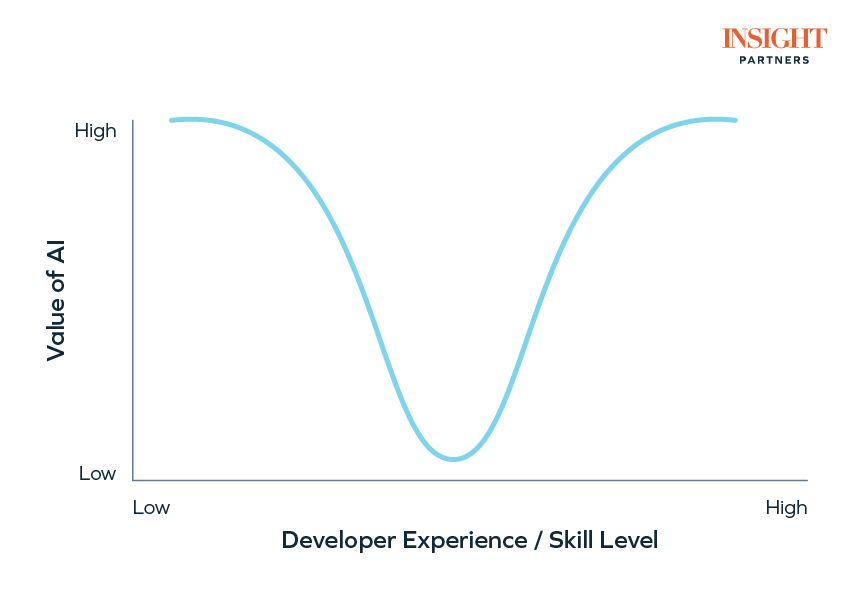
These views are based on the current “state of the art,” and things are changing quickly. What we see now might not be the same in the near future.
AI coding assistants give knowledge workers who don’t have technical backgrounds the ability to code. They also help less-experienced engineers by providing them with reliable boilerplate code, suggestions that complete their code automatically, and even the ability to convert text into SQL commands. If you’re a newer engineer working on tasks like creating basic APIs, integrating data, or implementing services built by senior engineers into specific applications, you can expect productivity gains of 50% or even more.
If you’re a newer engineer working on tasks like creating basic APIs, integrating data, or implementing services built by senior engineers into specific applications, you can expect productivity gains of 50% or even more.
However, if you’re a mid-level engineer, you might not see much of a productivity boost, and it’s possible you could even have some negative experiences. While mid-level and talented junior engineers do benefit from AI-generated code, their projects can be more complex, which can lead to more mistakes and time spent fixing those mistakes in the AI-generated code. They might also struggle to tell the difference between good and bad code, so they’ll spend extra time debugging.
We expect “10x” engineers to become “15x” engineers.
On the other hand, super-talented engineers, often known as “10X” engineers, will become even more productive. AI coding assistants aren’t as useful for really intricate programming tasks, and they might give suggestions that aren’t quite right. But the key difference is that these top engineers can quickly spot when the AI-generated code is flawed. Skilled engineers have unique ways of thinking and sometimes procrastinate, so the boost in productivity from AI really helps keep them engaged and productive. We expect “10x” engineers to become “15x” engineers.
Backend engineers will shift to frontend, security, and platform engineering
With AI taking care of some of the tasks that used to require hoards of lower-level backend engineers, those engineers will start moving into higher-demand roles like frontend development, security, and platform engineering.
SysAdmins and InfoSec professionals who lack advanced programming skills will have difficulty keeping up with the growing demand for creating custom applications and workflows. As a result, they might be gradually replaced by programmers who are more skilled and looking for jobs in these areas.
We’ll also likely see a wild new set of attack vectors in the cybersecurity space driven by generative AI, which will draw more sophisticated engineers to combat adversarial actors.
AI-powered coding = Faster pace of development, exposing bottlenecks that will refactor tooling in the SDLC
In the past five years, there has been a shift towards “shift-left” tools that empower developers to do early testing and evaluation usually handled downstream by “ops.” The premise is that it’s simpler to request developers acquire some knowledge about operations or security than to have operations and security teams poke around with a developer’s service.
Shift-left is starting to feel like “throw over the fence” left
But here’s the problem: all these requests are piling up, and it’s becoming too much for developers. They’re losing precious time and energy that should be spent on their main coding work. That’s where AI coding assistants come to the rescue. They can help eliminate some of the toil these shift-left tools introduce. And not just that, they can also make other tasks down the line, like monitoring and security, less cumbersome over time because AI can spot performance and security issues right when the code is being written.
The chart below highlights how we are starting to see value accrue across different stages of the software development supply chain in the new ‘AI World’ versus the ‘Old World’ (pre-shift-left) and ‘Shift-Left World.’
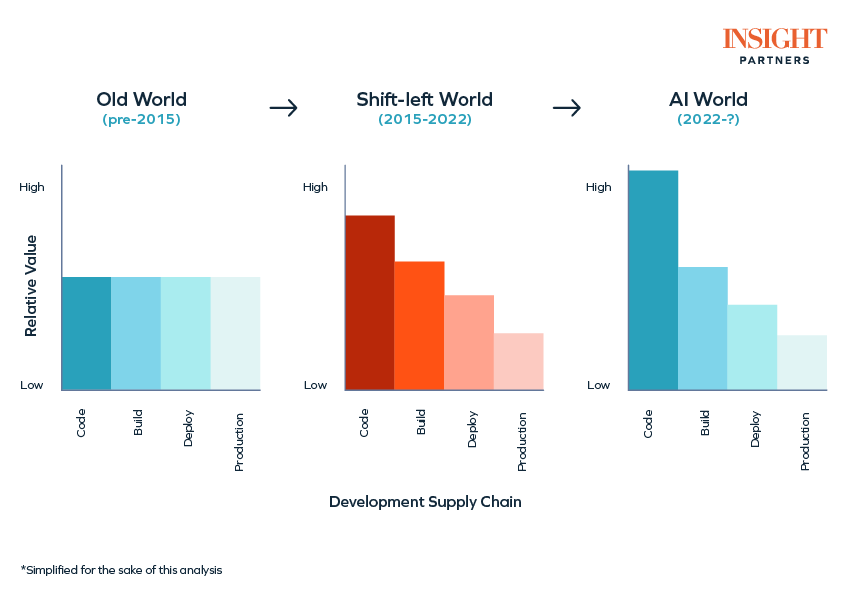
The impact of AI on developer tooling
The big picture is that more software will be released faster, thanks to AI. We’ve spent the past 15 years shifting from traditional waterfall development to agile methods. And now, with the help of AI, we’re going to experience another boost in productivity as development cycles speed up even more. This will greatly impact the developer tool ecosystem. We can only speculate the changes to come, but to call out a few predictions given what we know today:
Tools to fix broken builds will become more important.
When the dependencies on our local computers don’t match the ones on the build server, it causes builds to fail. This is a common issue because engineers struggle to stick to a consistent set of programming languages, versions, and libraries. AI-powered programming will accelerate development cycles, which will exacerbate this bottleneck in the development process. We can expect a growing demand for technologies that accelerate build processes (such as Incredibuild, EngFlow, Vercel/turborepo, nx.dev, warp.build) or directly tackle the issue of dependency sprawl (including Tangram, Flox).
AI-enabled shift-left tooling will become the norm.
Shift-left tooling for testing and vulnerability management is starting to feel like “throw it over the wall” left as developers are overburdened by a growing checklist to deploy software. This category of tools poses a potential bottleneck in the software supply chain, which will only worsen as the speed of software development continues to accelerate. To address this issue, shift-left tools need to automate a significant portion of the process away. Companies like Tabnine (AI-powered unit testing), Github Copilot (AI-powered vulnerability detection), Swimm (AI-powered internal documentation), and Codium (AI-powered integrity testing) are helping automate these processes away, and we expect companies new and old to add AI to their products over the next 12 months.
‘Overlay’ tools will become increasingly important in the era of AI.
Whether it’s in testing, observability, or security, the focus is gradually shifting away from manually interpreting data points to utilizing chat-style natural language processing (NLP) interfaces that synthesize information from multiple sources. Companies like Datadog and Splunk will begin employing large language models (LLMs) to automatically generate root-cause analysis, but their capabilities are constrained by the data available on their respective platforms. In this new landscape, overlay products such as BigPanda (an AIOPs platform) and Moment.dev (an Internal Developer Portal) hold a unique position. These tools integrate multiple data sources to enable more comprehensive analysis. Due to their inherent ability to offer a broader perspective, overlay tools are often the first tool a DevOps professional would look at before delving into specific details in a monitoring tool like Splunk or Grafana. If overlay tools nail the AI-powered experience, users will be more inclined to utilize those features and lean much less on the upstream tooling they integrate with.
Developer tools will get better at connecting the different stages of software development.
One of the problems we’ve always had is that developers write code one way, but the people in charge of making sure everything runs smoothly in production see something completely different. AI is becoming more and more core to the tools we use, so it’s important to make sure all the different parts work together and speak the same language. Microsoft, with their resources like Github and Azure, is in the best position to make this happen. In the startup world, we’re starting to see creative solutions like Korbit, which chains LLM agents to enrich code suggestion prompts using performance context from Datadog.
Code debugging will gain importance in observability.
While the intricacy of distributed systems has dominated the observability landscape in recent years, the future of AI-powered programming and serverless computing will shift the focus away from systems telemetry and towards application code. Troubleshooting and improving code will become the primary concern. We suspect the next game-changer in observability will transform the code debugging experience into an enjoyable and efficient process.
The race is on to become the Microsoft of the ‘private’ cloud.
Microsoft, with its full sweep of developer tooling from coding to deployment, will likely capture more and more developer mindshare as AI enforces the value of integration across the toolchain. But much like we see a GitLab for Github, there’s an opportunity to forge an integrated developer toolchain for the more security/privacy conscious companies who will be hesitant to rely so heavily on a single vendor.
Low-code tools will transform into interfaces for AI-driven code generation.
While low-code platforms will continue to provide reusable UI components and JavaScript abstractions, users will increasingly rely on AI to define intricate workflow functions. In the future, users will be able to describe an entire internal workflow in text, which the AI will then interpret and generate an application tailored to their needs. Superblocks and Airplane.dev are already moving in this direction, and the others will follow.
What’s Ahead?
It’s still early days and it’s hard to see beyond the next few steps along the yellow brick road. What we do know is that development is going to become more fun, challenging, and rewarding for creative developers around the world. AI is also going to reshape the entire developer tool landscape and rejigger the existing competitive moats that have defined industry shape.
If you are building in this space, we’d love to connect with you: mspiro@insightpartners.com
Editor’s note: Sourcegraph, Swimm, Incredibuild, Moment.dev, and BigPanda are Insight portfolio companies.




